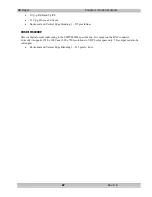
HD Player
Appendix B: An Introduction to MPEG
101
Rev. 6.8
Appendix B:
An Introduction to MPEG
It is not an exaggeration to say there is a revolution in the world of television broadcasting, often referred to as the
digital revolution. The ability of computers and related technology to process digital video, is leading to new
possibilities of interactivity. MPEG is one of the key technologies driving this revolution.
In an analog communication system, a transmitter sends voltage variations, which a receiver uses to control
transducers such as loud speakers, or TV cathode ray tubes. In a digital system the transmitter encodes the analog
voltage into a sequence of zeros and ones (called bits); this bit stream is transmitted to a receiver. The receiver
reconverts or “decodes” the bit stream back into the original analog voltage variations.
Primary advantages of digital representation of information are ease of manipulation and robustness of the data
stream. Digital data can be copied an infinite number of times and the quality will not degrade. Digital data can be
easily manipulated with a computer and distributed through a large number of different mediums.
Digital and Compression Video
Having determined that storing analog signals in a digital form is a good thing, what does this mean for television?
In the early days of digital video processing it was determined that the resolution for a digital representation of an
NTSC frame (single picture), needs to be 720 pixels across by 480 lines to produce an acceptable quality image.
At this resolution about 20 Mega bytes of data is required to represent a second of NTSC standard video.
To represent a High Definition signal over 5 times this quantity of data is required. Even with today’s computing
technology, these are huge numbers to work with. A method is needed to reduce the amount of data that is used to
represent the video stream. This is called Compression. Compression falls into two basic types, Loss-less and
Lossy. As the name implies, loss-less compression is able to recreate the original digital data exactly. Lossy
compression uses information in the input stream, which can be discarded without noticeable degradation of the
stream.
What is MPEG?
MPEG (Moving Picture Experts Group) was started in 1988 as a working group within ISO/IEC with the aim of
defining standards for digital compression of audio-visual signals. MPEG's first project, MPEG-1, was published
in 1993 as ISO/IEC 11172 [1]. It is a three-part standard, defining audio and video compression coding methods,
and a multiplexing system, for interleaving audio and video data so that they can be played back together. MPEG-
1 principally supports video coding up to about 1.5 Mbit/s giving quality similar to VHS and stereo audio at 192
bit/s. It is used in the CD-i and Video-CD systems for storing video and audio on CD-ROM.
During 1990, MPEG recognized the need for a second, related standard for coding video for broadcast formats at
higher data rates. The MPEG-2 standard [2] is capable of coding standard-definition television at bit rates from
about 3-15 Mbit/s and high-definition television at 15-80 Mbit/s. MPEG-2 extends the stereo audio capabilities of
MPEG-1 to multi-channel surround sound coding. MPEG-2 decoders will also decode MPEG-1 bit streams.
Drafts of the audio, video and systems specifications were completed in November 1993 and the ISO/IEC
approval process was completed in November 1994. The final text was published in 1995.
MPEG-2 aims to be a
generic
video coding system supporting a diverse range of applications. Different
algorithmic 'tools', developed for many applications, have been integrated into the full standard. To implement all
the features of the standard in all decoders is unnecessarily complex and a waste of bandwidth, so a small number
of subsets of the full standard, known as
profiles
and
levels
, have been defined:
•
A
profile
is a subset of algorithmic tools
•
A
level
identifies a set of constraints on parameter values (such as picture size and bit rate).
Содержание MS9200P
Страница 10: ......
Страница 78: ...HD Player Chapter 12 Remote Control Protocols 78 Rev 6 8 The Player will respond with OK or ERROR ...
Страница 88: ......
Страница 93: ...HD Player Chapter 14 Application Notes 93 Rev 6 8 ...






























